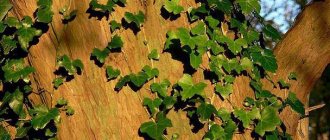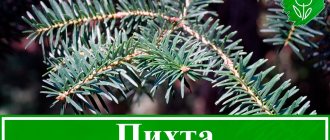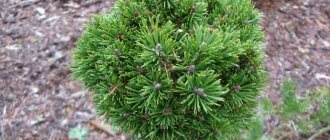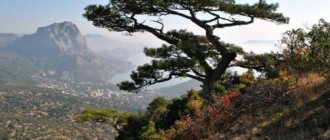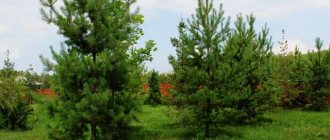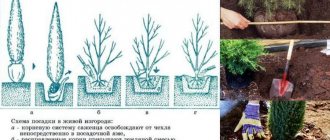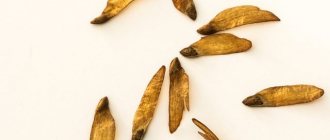Loading…
Loading…
Weymouth pine is an ornamental plant that is used by many summer residents and gardeners to recreate a real pine forest on their plot. Planting and caring for Weymouth pine has its own rules and characteristics. If you follow them, you can grow a powerful and aesthetically attractive tree that will decorate any patio, rocky garden or flower garden.
Botanical description
Weymouth pine (pinus strobus) is a tree with a lush and rounded crown. Natural habitat is North America. The plant came to Europe thanks to the English navigator George Weymouth. A man brought this type of tree to England at the beginning of the 17th century. However, the culture could not take root in Britain. Here she was often attacked by fungi.
At a young age, the Weymouth mountain pine grows quite quickly. During the first 30 years of life, it grows up to 20 m in height. Further, plant growth decreases significantly. For several years after planting, the light bark of the tree does not show any blemishes. At a more mature age, the bark begins to darken and become covered with cracks.
The branches of the tree are thin, and they can be either smooth or covered with fluff. The needles grow in bunches of 5 pieces. The needles have a curved shape and are about 10 cm long. The color of the needles can vary from whitish-green to dark green.
The plant blooms from April to May. The cones ripen in the fall a year after pollination. After this, they fall off, dropping seeds with wings. The ovoid-shaped buds have a brown tint and emit a resinous smell.
This type of wood is resistant to negative environmental influences. Pine is able to tolerate polluted air, frost and other similar climatic factors. The average lifespan of a pine tree is 400 years.
Features of Weymouth pine
Weymouth pine, also called white pine, is a perennial evergreen tree from the Pinaceae family. It got its name from the famous English explorer and scientist Weymouth, who first brought pine seedlings from North America to Europe.
Today, Weymouth pine also grows in Mexico, Canada and Guatemala.
Main botanical features of Weymouth pine:
- Weymouth pine is distinguished by its enormous size - an adult tree can reach 40-80 m and up to 1.5-2 m in diameter.
- The crown has a regular cone shape and becomes more rounded and spreading over time.
- The pine trunk is erect, covered with smooth and delicate gray bark. With age, the bark darkens, becomes rougher and becomes covered with longitudinal cracks.
- Bluish-green needles with a bluish tint. Coniferous needles are collected in tassel bunches of 5 pieces, their length reaches 8-10 cm. The needles grow upward and are completely renewed every 3-4 years.
- Original varieties of Vemutov pine with golden and silver needles have been developed, as well as ones that change color throughout the year.
- As a dioecious tree, Weymouth pine has female and male cones. The first ones are brown, have an oblong, oval shape, up to 18-20 cm long, the second ones are round, yellow, up to 1.5-2 cm in size.
- Weymouth pine is a long-liver. She can live up to 400-500 years.
Weymouth pine is characterized by very fast growth. During the first 35-40 years after planting, the tree grows up to 15-20 m. After this, the growth rate decreases. The maximum height of an adult tree is 80 m.
Types and varieties
In nature, there are several varieties of Weymouth pine:
- Weymouth Minim pine. This variety began to be cultivated in the middle of the 20th century. The plant has a dwarf shape and reaches a height of no more than 1 m. The pinus strobus minima variety has a spherical crown, which over time begins to resemble a pillow. The culture grows slowly, on average 5-7 cm per year;
- Weymouth pine Minimus. A dwarf tree 0.8-1 m high. It has soft bluish-green needles. The plant is able to adapt to cold climates and also withstand severe frosts and snowfalls;
- Weymouth pine Makopin. This variety grows as a shrub. Conifer needles are long, collected in bunches. Green buds turn brown when ripe. The plant can grow in any soil, but does not tolerate the sun;
- Weymouth pine Himmelblau. The pinus strobus himmelblau variety is considered the bluest of all the others. The tree is up to 3 m high. It has a bush-like shape. Pine is shade-tolerant, but at the same time demanding of moisture. Prefers to grow in a sunny area in well-drained soil;
- Weymouth pine Rhinehaus. A dwarf tree about 150 cm high. The dense crown has a spherical shape. The crop does not tolerate moisture well, so it is planted in well-moistened soils. The pinus strobus rheinhaus variety is often grown in heather and rocky gardens;
- Weymouth Pendula pine. A tree with long branches and a weeping crown. Sometimes the plant is grown with support. In this case, the height of the tree reaches 4 m. Growing without support, the crop will grow 90-120 cm. Thin needles have a bluish-green tint. Grows well on slightly acidic soils and black soil;
- Weymouth Nana pine. The culture grows in the form of a bush with a height of 1 to 3 meters. The lower shoots are located parallel to the ground, and the upper ones are directed to the sides. The diameter of the symmetrical crown is about 2.5 m. The needles are thin, green with a blue tint. Shrubs grown using seeds are distinguished by high endurance compared to specimens obtained vegetatively;
- Weymouth pine Fastigiata. A fast-growing tree in the form of a majestic column. The fastigiata variety is frost-resistant (down to -35 ° C), shade-tolerant and not demanding of light. The culture is capable of growing in urban environments. Often used to create alleys;
- Weymouth Blue pine. Decorative view of mountain pine. The variety got its name thanks to its pale blue needles. At a young age, the crown resembles a pyramid in shape. Prefers to grow in moist soil, but has no light requirements;
- Weymouth Radiata pine. A sun-loving and frost-resistant tree with a conical and spherical crown. The radiata variety is often used in landscape design. The plant does well in alkaline soils, but does not tolerate heavy soil. It can grow in the city near industrial facilities.
In addition to the above varieties, Weymouth pines have other varieties. For example, the slow-growing Alba variety grows only 20 cm in height. Edel, in turn, has a spherical crown shape and grows in any soil.
Landing rules
When growing Weymouth pine, it is important to choose a good location, planting material and provide the seedlings with proper conditions at the initial stage of life.
The best time for planting is spring (late April or early May). In the southern regions it can be planted in the fall, but no later than the first half of September.
Selection of seedlings
You can buy real bushes with all varietal characteristics only in a gardening nursery.
It is better to give preference to plants 2-3 years old with a closed root system - they take root better and faster than young conifers with open roots.
Price for one copy is from 300 to 3800 rubles.
Inspect the above-ground part - it should be alive, with flexible, intact shoots and needles of a uniform color. Yellow, black and red spots, as well as cracks and breaks are signs of health problems, so it is better to avoid such pines.
Buy seedlings in containers or with a ball of earth wrapped in burlap. Before planting, they should be saturated with moisture.
Preparing the site
Almost all types of Weymouth pine prefer to grow in a sunny place with some shade during the midday hours. To ensure this condition, you need to choose a bed near tall trees with a spreading crown.
You can plant conifers near a fence, gazebo or against the walls of a house.
The soil is light, loose, with a high content of fertile components. If you plant on sandy loam, you need to add a couple of buckets of clay, when planting on loam - 20 kg of sand and peat.
At a high acidity level (from 6 units), add calcite, chalk or slaked lime - 350 per 1 m². Then the area is dug up, leveled, and watered.
Landing technique
When growing in groups, holes are dug at a distance of 3 m with a distance in a row of 2 m - then the seedlings will fully develop and there will be no competition for space, moisture and nutrients.
The dimensions of the planting holes should be twice the dimensions of the earthen ball.
¼ of the volume is filled with drainage (pebbles or crushed stone). Up to half of it is sprinkled with a fertile composition of peat, turf, sand and pine sawdust (2:2:1:1).
They spill water (10 liters per hole), then lower the roots, cover them to the top with earth, and compact them. Moisten at the rate of two buckets per seedling. Mulch with a thick layer of peat.
When planting, it is important that the root collar remains 5-6 cm higher from the soil surface, otherwise the conifer will quickly rot and die.
Spreading
The birthplace of pine is America. Today the culture is widespread in almost every state of the country, from Minnesota to Georgia. In addition, the tree grows in Canada on the rocky island of Newfoundland, as well as in the provinces of Nova Scotia, Manitoba, Quebec, etc.
Pine appeared in Russia at the end of the 18th century. At first, the crop was planted in private gardens as an exotic plant. Over time, the tree appeared in the European part of the country. Some varieties can be found in the Voronezh, Smolensk and Pskov regions.
Planting and care
Weymouth pine is unpretentious to soils. Low humus sandy soil is suitable for planting. The acidity of the earth should be neutral, within 5 units. pH. It is allowed to plant seedlings in open ground at the end of April or in September.
The plant is planted in a hole slightly larger than the volume of the rhizome. A drainage layer of expanded clay is laid at the bottom of the hole. The planting hole is filled with soil mixture and then watered.
Watering is necessary for seedlings in the first year of life. Adult specimens need moisture only in summer, especially in hot weather. Pine tree care also includes mulching and sanitary pruning in spring and autumn. As a top dressing, ready-made fertilizers designed specifically for conifers are applied.
Reproduction
Reproduction of pine crops occurs in different ways. Most often, the plant is propagated by seeds or grafting. In rare cases, cuttings are resorted to. However, the survival rate of planting material remains low.
When planting seeds, the gardener must stratify them in advance. To do this, keep the material in a cold place for several months. If the gardener’s plans include obtaining a varietal type of Weymouth pine, then planting the seeds is carried out with subsequent grafting.
When choosing a propagation method, the gardener must know that with the vegetative method he will receive an exact copy of the “parent”. When propagating from seeds, it is impossible to guarantee the preservation of the phenotype and genotype of the plant.
Diseases and pests
A plant of any variety can become sick or be attacked by pests. To prevent this, it is necessary to collect fallen needles and treat the crop with copper-containing substances.
The most common disease that can affect Weymouth pine is seryanka or blister rust. The disease is caused by rust fungi. At first, swellings appear on the branches and trunk, covered with sulfur-yellow formations. The mycelium of the fungus spreads throughout the wood, while the bark begins to die and falls off. Seryanka can be controlled by removing infected trees.
Pests that attack coniferous plants include:
- Brown pine aphids thrive on young shoots in the spring and begin to actively reproduce in the summer. To combat aphids, use the preparations Confidor Maxi or Calypso.
- Pine hermes - affects only coniferous plants, while feeding on their sap. The parasite can be detected in late spring. The needles turn yellow and crumble, and sometimes become covered with a whitish coating.
- Coniferous scale insects cover plants with “cotton wool” and sometimes form tumors. In this case, gardeners advise spraying the plants with tobacco tincture.
To prevent extensive damage to trees, it is necessary to regularly monitor the condition of the plant. Many diseases can be eliminated by using chemicals. In rare cases, digging up the root zone will be necessary.
Pests
Blistering rust. Forms growths on the trunk that resemble bubbles. Their color ranges from light yellow to orange.
Spider mite. A thin cobweb forms between the needles and on the trunk; the mite itself is very difficult to notice, since it is microscopic in size. Like most pests, the mite feeds on the sap of the plant, which is why the needles begin to turn yellow and dry out.
Hermes. This pest is called the pine aphid. They live in colonies, like ordinary aphids. Feeding on the sap of the Hermes plant, they pierce the needles, necrosis occurs at the puncture sites, and the pine begins to dry out and turn yellow. A clear sign that your tree is infested with Hermes is a dark gray coating.
Pine owl. The threat is not the butterfly itself, but its voracious caterpillars, which can cause major damage to the entire tree in a short time.
The sawfly beetle lays larvae on coniferous and fruit trees. The harmful larvae look like caterpillars and feed on the sap of young shoots and annual growths.
Meaning and Application
Weymouth pine wood has a soft and uniform structure. It is excellent for making furniture and for interior decoration. Wood is used to make high-quality building material that is easy to process. That is why several centuries ago pine trees were mercilessly cut down. Today this coniferous crop is a protected species.
Use in landscape design
Landscape designers often use evergreens to create various types of compositions. The variety of shapes of Weymouth pine allows it to be used in any corner of the garden area.
Low-growing varieties are placed in small areas next to rocky embankments. Larger specimens require more space.
Tall conifers sometimes delimit space. Perennial flowers and deciduous shrubs are planted next to them. It is also recommended to plant apple trees, maples, rowan and barberry nearby.
Landscape use
Due to the variety of varieties, this crop is very popular in landscape design:
- it is planted singly and used in group plantings to create a lush evergreen hedge;
- combine with other conifers of different heights and diameters;
- involved in the creation of rock gardens, mixborders, ridges and rockeries;
- used for landscaping park areas, alleys, and planted surrounded by perennial flowers - roses, hydrangeas.
Weymouth pine from history to agricultural technology.
Roumelian pine and Weymouth pine
Review of coniferous plants: cedar pine, Weymouth pine, dwarf cedar.
